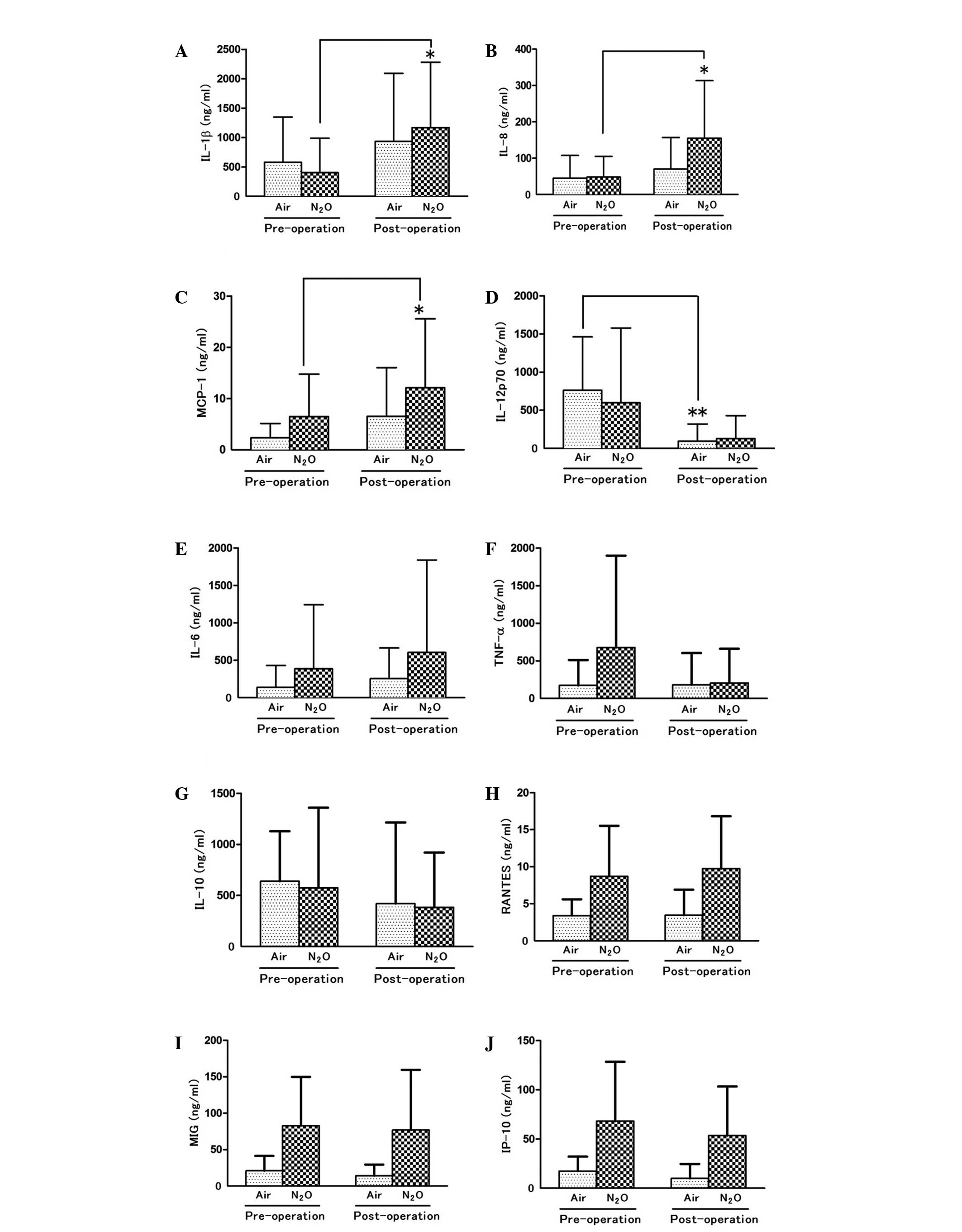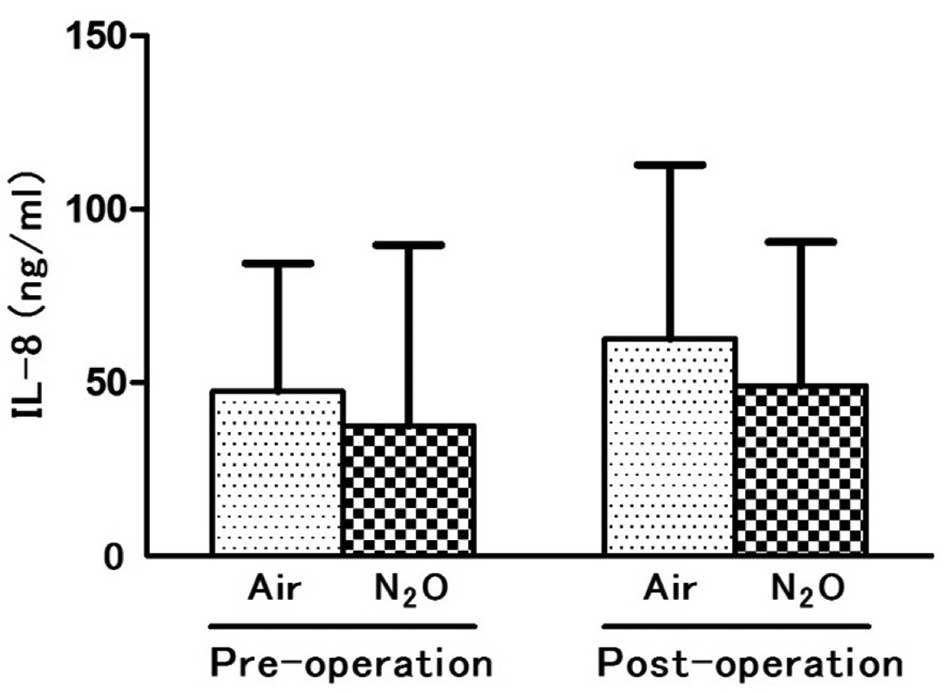|
1
|
Weiser TG, Regenbogen SE, Thompson KD, et
al: An estimation of the global volume of surgery: a modelling
strategy based on available data. Lancet. 372:139–144.
2008.PubMed/NCBI
|
|
2
|
Fisher DM and Zwass MS: MAC of desflurane
in 60% nitrous oxide in infants and children. Anesthesiology.
76:354–356. 1992.
|
|
3
|
Gupta K, Vohra V and Sood J: The role of
magnesium as an adjuvant during general anaesthesia. Anaesthesia.
61:1058–1063. 2006. View Article : Google Scholar : PubMed/NCBI
|
|
4
|
Myles PS, Leslie K, Chan MT, et al; ENIGMA
Trial Group. Avoidance of nitrous oxide for patients undergoing
major surgery: a randomized controlled trial. Anesthesiology.
107:221–231. 2007. View Article : Google Scholar : PubMed/NCBI
|
|
5
|
Myles PS, Leslie K, Peyton P, et al; ANZCA
Trials Group. Nitrous oxide and perioperative cardiac morbidity
(ENIGMA-II) Trial: rationale and design. Am Heart J. 157:488–494.
2009. View Article : Google Scholar : PubMed/NCBI
|
|
6
|
Urman RD and Desai SP: History of
anesthesia for ambulatory surgery. Curr Opin Anaesthesiol.
25:641–647. 2012.PubMed/NCBI
|
|
7
|
Nunn JF: Clinical aspects of the
interaction between nitrous oxide and vitamin B12. Br J Anaesth.
59:3–13. 1987. View Article : Google Scholar : PubMed/NCBI
|
|
8
|
Myles PS, Leslie K, Silbert B, Paech M and
Peyton P: A review of the risks and benefits of nitrous oxide in
current anaesthetic practice. Anaesth Intensive Care. 32:165–172.
2004.PubMed/NCBI
|
|
9
|
Akca O, Lenhardt R, Fleischmann E, et al:
Nitrous oxide increases the incidence of bowel distension in
patients undergoing elective colon resection. Acta Anaesthesiol
Scand. 48:894–898. 2004. View Article : Google Scholar : PubMed/NCBI
|
|
10
|
Kaisti KK, Langsjo JW, Aalto S, et al:
Effects of sevoflurane, propofol, and adjunct nitrous oxide on
regional cerebral blood flow, oxygen consumption, and blood volume
in humans. Anesthesiology. 99:603–613. 2003.PubMed/NCBI
|
|
11
|
Marie RM, Le Biez E, Busson P, et al:
Nitrous oxide anesthesia-associated myelopathy. Arch Neurol.
57:380–382. 2000. View Article : Google Scholar : PubMed/NCBI
|
|
12
|
Schilling RF: Is nitrous oxide a dangerous
anesthetic for vitamin B12-deficient subjects. JAMA. 255:1605–1606.
1986. View Article : Google Scholar : PubMed/NCBI
|
|
13
|
Parbrook GD: Leucopenic effects of
prolonged nitrous oxide treatment. Br J Anaesth. 39:119–127. 1967.
View Article : Google Scholar : PubMed/NCBI
|
|
14
|
Mazze RI, Wilson AI, Rice SA and Baden JM:
Reproduction and fetal development in rats exposed to nitrous
oxide. Teratology. 30:259–265. 1984. View Article : Google Scholar : PubMed/NCBI
|
|
15
|
Badner NH, Beattie WS, Freeman D and
Spence JD: Nitrous oxide-induced increased homocysteine
concentrations are associated with increased postoperative
myocardial ischemia in patients undergoing carotid endarterectomy.
Anesth Analg. 91:1073–1079. 2000.
|
|
16
|
Badner NH, Drader K, Freeman D and Spence
JD: The use of intraoperative nitrous oxide leads to postoperative
increases in plasma homocysteine. Anesth Analg. 87:711–713.
1998.PubMed/NCBI
|
|
17
|
Tramer M, Moore A and McQuay H:
Meta-analytic comparison of prophylactic antiemetic efficacy for
postoperative nausea and vomiting: Propofol anaesthesia versus
omitting nitrous oxide versus total i.v. anaesthesia with propofol.
Br J Anaesth. 78:256–259. 1997. View Article : Google Scholar
|
|
18
|
Apfel CC, Korttila K, Abdalla M, et al: A
factorial trial of six interventions for the prevention of
postoperative nausea and vomiting. N Engl J Med. 350:2441–2451.
2004. View Article : Google Scholar : PubMed/NCBI
|
|
19
|
Macario A, Weinger M, Carney S and Kim A:
Which clinical anesthesia outcomes are important to avoid? The
perspective of patients. Anesth Analg. 89:652–658. 1999.PubMed/NCBI
|
|
20
|
Greif R, Akca O, Horn EP, Kurz A and
Sessler DI: Supplemental perioperative oxygen to reduce the
incidence of surgical wound infection. N Engl J Med. 342:161–167.
2000. View Article : Google Scholar
|
|
21
|
Belda FJ, Aguilera L, Garcia de la
Asunción J, et al: Supplemental perioperative oxygen and the risk
of surgical wound infection. JAMA. 294:2035–2042. 2005. View Article : Google Scholar : PubMed/NCBI
|
|
22
|
Grief R, Laciny S, Rapf B, Hickle RS and
Sessler DI: Supplemental oxygen reduces the incidence of
postoperative nausea and vomiting. Anesthesiology. 91:1246–1252.
1999. View Article : Google Scholar : PubMed/NCBI
|
|
23
|
Henderson KA, Raj N and Hall JE: The use
of nitrous oxide in anaesthetic practice: a questionnaire survey.
Anaesthesia. 57:1155–1158. 2002. View Article : Google Scholar : PubMed/NCBI
|
|
24
|
Schneemilch CE, Hachenberg T, Ansorge S,
Ittenson A and Bank U: Effects of different anaesthetic agents on
immune cell function in vitro. Eur J Anaesthesiol. 22:616–623.
2005. View Article : Google Scholar : PubMed/NCBI
|
|
25
|
Moudgil GC, Gordon J and Forrest JB:
Comparative effects of volatile anaesthetic agents and nitrous
oxide on human leucocyte chemotaxis in vitro. Can Anaesth Soc J.
31:631–637. 1984. View Article : Google Scholar : PubMed/NCBI
|
|
26
|
Ishizaka A, Watanabe M, Yamashita T, et
al: New bronchoscopic microsample probe to measure the biochemical
constituents in epithelial lining fluid of patients with acute
respiratory distress syndrome. Crit Care Med. 29:896–898. 2001.
View Article : Google Scholar
|
|
27
|
Simon RH and Paine R III: Participation of
pulmonary alveolar epithelial cells in lung inflammation. J Lab
Clin Med. 126:108–118. 1995.PubMed/NCBI
|
|
28
|
Takizawa H: Airway epithelial cells as
regulators of airway inflammation. Int J Mol Med. 1:367–378.
1998.PubMed/NCBI
|
|
29
|
De Conno E, Steurer MP, Wittlinger M, et
al: Anesthetic-induced improvement of the inflammatory response to
one-lung ventilation. Anesthesiology. 110:1316–1326.
2009.PubMed/NCBI
|
|
30
|
Vozzelli MA, Mason SN, Whorton MH and
Auten RL Jr: Antimacrophage chemokine treatment prevents neutrophil
and macrophage influx in hyperoxia-exposed newborn rat lung. Am J
Physiol Lung Cell Mol Physiol. 286:L488–L493. 2004. View Article : Google Scholar : PubMed/NCBI
|
|
31
|
Beck-Schimmer B, Schwendener R, Pasch T,
Reyes L, Booy C and Schimmer RC: Alveolar macrophages regulate
neutrophil recruitment in endotoxin-induced lung injury. Respir
Res. 6:61–66. 2005. View Article : Google Scholar : PubMed/NCBI
|
|
32
|
Brunda MJ: Interleukin-12. J Leukoc Biol.
55:280–288. 1994.
|
|
33
|
Tanaka K, Ludwig LM, Kersten JR, Pagel PS
and Warltier DC: Mechanisms of cardioprotection by volatile
anesthetics. Anesthesiology. 100:707–721. 2004. View Article : Google Scholar : PubMed/NCBI
|
|
34
|
Reutershan J, Chang D, Hayes JK and Ley K:
Protective effects of isoflurane pretreatment in endotoxin-induced
lung injury. Anesthesiology. 104:511–517. 2006. View Article : Google Scholar : PubMed/NCBI
|
|
35
|
Lee HT, Kim M, Jan M and Emala CW:
Anti-inflammatory and antinecrotic effects of the volatile
anesthetic sevoflurane in kidney proximal tubule cells. Am J
Physiol Renal Physiol. 291:67–78. 2006. View Article : Google Scholar : PubMed/NCBI
|
|
36
|
Suter D, Spahn DR, Blumenthal S, Reyes L,
Booy C, Z’Graggen BR and Beck-Schimmer B: The immunomodulatory
effect of sevoflurane in endotoxin-injured alveolar epithelial
cells. Anesth Analg. 104:638–645. 2007. View Article : Google Scholar : PubMed/NCBI
|
|
37
|
Loop T, Scheiermann P, Doviakue D, et al:
Sevoflurane inhibits phorbol-myristate-acetate-induced activator
protein-1 activation in human T lymphocytes in vitro: potential
role of the p38-stress kinase pathway. Anesthesiology. 101:710–721.
2004. View Article : Google Scholar
|
|
38
|
Frohlich D, Rothe G, Wittmann S, Schmitz
G, Schmid P, Taeger K and Hobbhahn J: Nitrous oxide impairs the
neutrophil oxidative response. Anesthesiology. 88:1281–1290. 1998.
View Article : Google Scholar : PubMed/NCBI
|
|
39
|
Hill GE, English JB, Stanley TH, Kawamura
R, Loeser EA and Hill HR: Nitrous oxide and neutrophil chemotaxis
in man. Br J Anaesth. 50:555–558. 1978. View Article : Google Scholar : PubMed/NCBI
|
|
40
|
Kripke BJ, Kupferman A and Luu KC:
Suppression of chemotaxis to corneal inflammation by nitrous oxide.
Zhonghua Min Guo Wei Sheng Wu Ji Mian Yi Xue Za Zhi. 20:302–310.
1987.PubMed/NCBI
|
|
41
|
Nunn JF and O’Morain C: Nitrous oxide
decreases motility of human neutrophils in vitro. Anesthesiology.
56:45–48. 1982. View Article : Google Scholar : PubMed/NCBI
|
|
42
|
Welch WD: Effect of enflurane, isoflurane,
and nitrous oxide on the microbicidal activity of human
polymorphonuclear leukocytes. Anesthesiology. 61:188–192. 1984.
View Article : Google Scholar : PubMed/NCBI
|
|
43
|
Welch WD and Zaccari J: Effect of
halothane and N2O on the oxidative activity of human
neutrophils. Anesthesiology. 57:172–176. 1982.
|
|
44
|
Bardosi L, Bardosi A and Gabius HJ:
Changes of expression of endogenous sugar receptors by
polymorphonuclear leukocytes after prolonged anaesthesia and
surgery. Can J Anaesth. 39:143–150. 1992. View Article : Google Scholar : PubMed/NCBI
|
|
45
|
Frohlich D, Rothe G, Schmitz G and Taeger
K: Nitrous oxide impairs the signaling of neutrophils downstream of
receptors. Toxicol Lett. 100–101:121–127. 1998.PubMed/NCBI
|
|
46
|
Lehmberg J, Waldner M, Baethmann A and Uhl
E: Inflammatory response to nitrous oxide in the central nervous
system. Brain Res. 30:1246:88–95. 2008. View Article : Google Scholar : PubMed/NCBI
|
|
47
|
Sugasawa Y, Yamaguchi K, Kumakura S,
Murakami T, Suzuki K, Nagaoka I and Inada E: Effects of sevoflurane
and propofol on pulmonary inflammatory responses during lung
resection. J Anesth. 26:62–69. 2012. View Article : Google Scholar : PubMed/NCBI
|
















